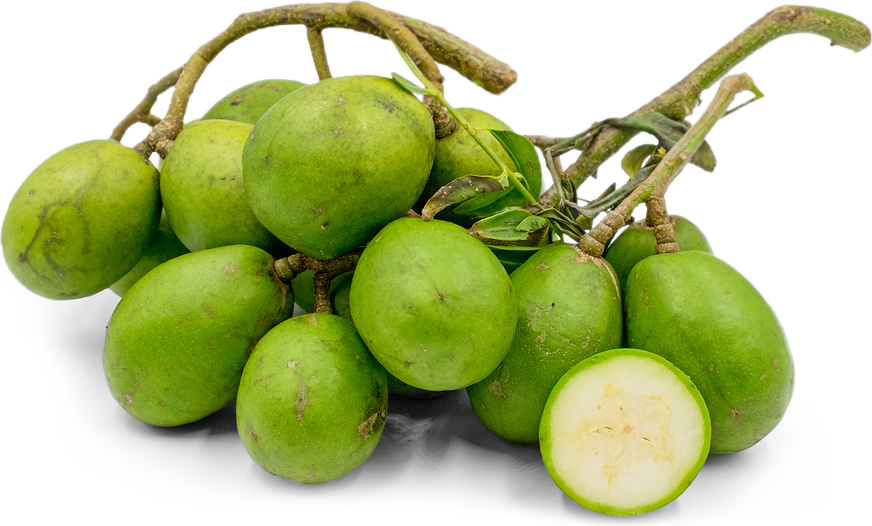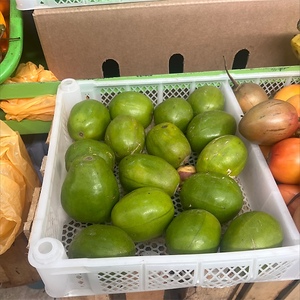


Ambarella Fruit
Estimated Inventory, lb : 0
Description/Taste
Ambarella fruits are small to medium in size, averaging 18-20 centimeters in diameter and 6-9 centimeters in length, and grow in dangling clusters of up to twelve fruits. The oval to ellipsoidal fruits have tough, thin skin that may bear some russeting and matures from green to yellow. Underneath the surface, the flesh is dense, hard, juicy, and ranges in color from pale yellow to white. In the center of the flesh, there is also a fibrous pit that contains a few, flat seeds. As the fruit matures, the coarse nature of the pit extends into the flesh creating a tougher consistency. Ambarella fruits are crisp and semi-juicy with a mildly acidic, green flavor emitting notes of pineapple and mango.
Seasons/Availability
Ambarella fruits are available in the fall through winter.
Current Facts
Ambarella, botanically classified as Spondias dulcis, are clustered fruits that grow on tropical trees reaching up to twenty meters in height and belongs to the Anacardiaceae family. Known by many names including the Hog Apple, Kedondong, Umbra, Buah Long Long, and June Plum, Ambarella trees are found in tropical forests across the world and are used for their timber and fruits. The fruits fall to the ground while still unripe, and this green state is the most popular version of the fruits to be gathered and consumed. When young, the fruits are favored for their mild flesh and are utilized as a neutral vessel to add salts, seasonings, and sugar. When the fruits mature, the flavor becomes more tart and the texture fibrous. In local markets in Asia, green Ambarella fruits are the most commonly sold versions, while the yellow, more mature versions are also sold but on a much smaller scale.
Nutritional Value
Ambarella fruits contain vitamins A, B, and C, iron, phosphorus, calcium, and fiber.
Applications
Ambarella fruits are versatile and can be consumed in both raw and cooked applications. When eaten fresh, the green fruits are the preferred maturity and are sprinkled with salt, sugar, shrimp paste, and chile powder for added flavoring. The fruits can also be sliced and tossed into fruit and green salads for extra crunch, juiced and mixed in with other fruits, or dried and made into a spicy paste that is used as a condiment. In addition to raw preparations, Ambarella fruits can be cooked and are often made into jams, preserves, and jellies. They are also cooked into soups, curries, and stews, pickled for extended use, or cooked in sugar water and mashed to create an applesauce-like consistency. In Samoa, Ambarella fruits are used to make otai, which is a refreshing drink made up of watermelon, coconut, pineapple, Ambarella, and lime, while in Indonesia, the fruits are steamed and consumed as a side dish to salted fish and rice. The fruits are also used to make a sour beer in Vietnam, and the leaves of the Ambarella plant are edible and are used in salads or are lightly sautéed. Ambarella fruit pairs well with onions, ginger, cinnamon, cardamom, curry leaves, and mustard leaves. The fruits will keep up to one week when stored at room temperature and 2-4 weeks when stored in the refrigerator.
Ethnic/Cultural Info
In Asia, Ambarella fruits are used in Ayurvedic medicine to help reduce many different symptoms associated with digestion and colds. The fruits are shredded into water and consumed as a drink to help alleviate coughs and fevers, and the flesh contains fiber which can help clear the digestive tract and eliminate constipation. The leaves are also used as a natural aid to help treat diarrhea and are boiled into a tea to soothe sore throats and coughs.
Geography/History
Ambarella fruits are native to Polynesia and the region known as Melanesia which includes islands such as Papua New Guinea, Solomon Islands, Fiji, and Vanuatu. The fruit was then introduced to Asia and then Jamaica in 1782 and was spread throughout the Caribbean and into South America. Later in 1909, it was planted in Florida in the United States and has also become naturalized in Australia. Today Ambarella fruits are widely found in tropical regions across the world and are sold in fresh local markets in Asia, Southeast Asia, Polynesia, Melanesia, Australia, Africa, the Caribbean, and North, Central, and South America.
Recipe Ideas
Recipes that include Ambarella Fruit. One









